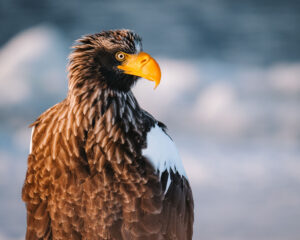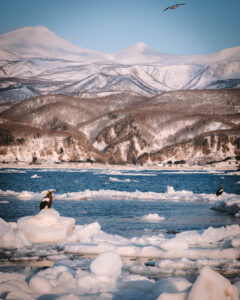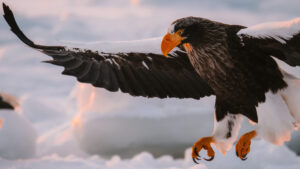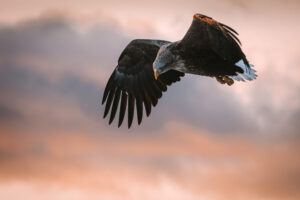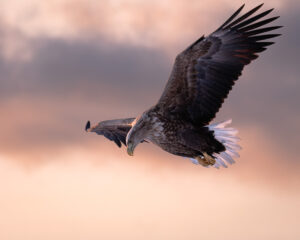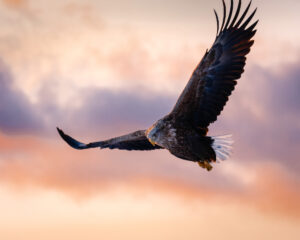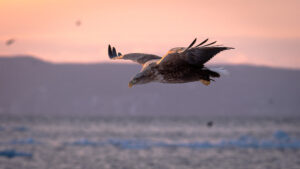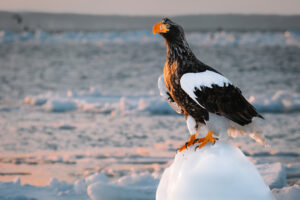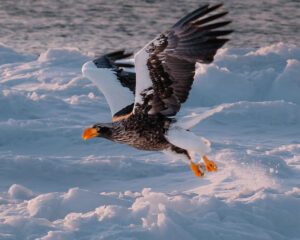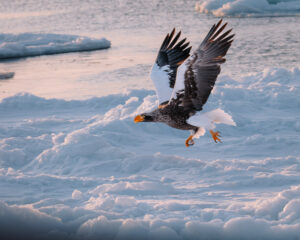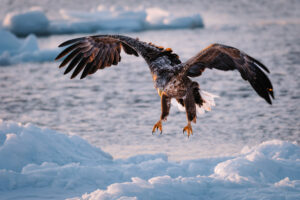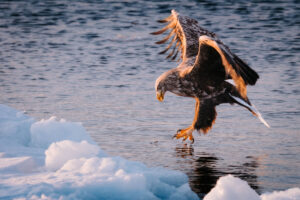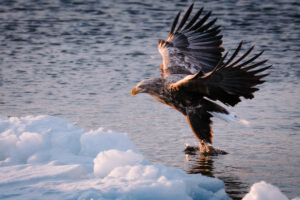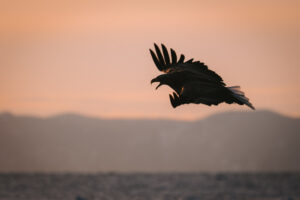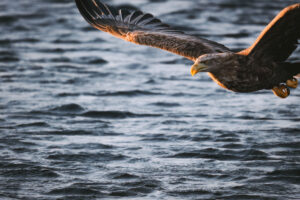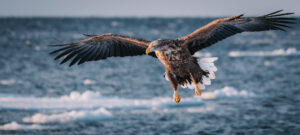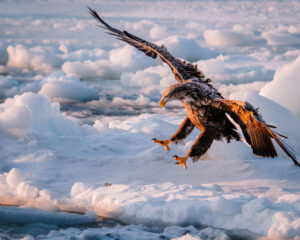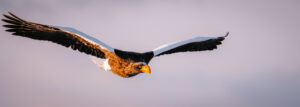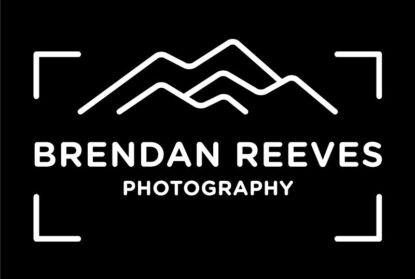How to Photograph Steller’s Sea Eagles in Hokkaido’s Rausu
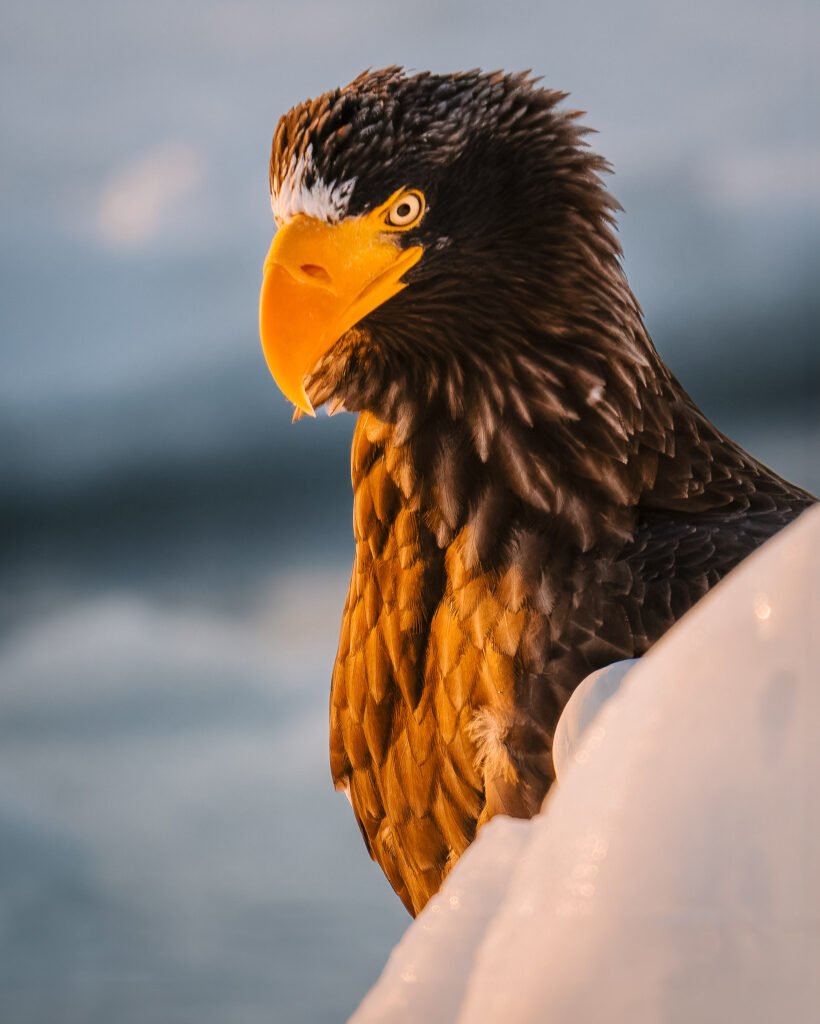
If you’ve ever wondered how to photograph Steller’s sea eagles, Rausu in Hokkaido is the place to do it. It’s one of the most thrilling wildlife experiences Japan has to offer. These massive, powerful birds—among the largest eagles in the world—are both majestic and intimidating. The first time I saw one, I was stunned by its sheer size and presence. Traveling across snowy Hokkaido to the remote town of Rausu, on the edge of the Shiretoko Peninsula, to photograph them was unforgettable—and something I hope to do again soon.
Steller’s sea eagles are native to Russia’s Far East, where they breed on Sakhalin and the Kuril Islands. During the harsh winter months, they migrate south to the slightly milder climate of Japan’s northernmost island, Hokkaido. Here, they can often be seen along the coastline between November and March, though an occasional eagle might remain year-round, opting not to return north for summer.
One of the best places to observe these eagles in Hokkaido is on the drift ice that floats around the island’s eastern coast in winter. The eagles perch on the ice, hunting for fish and scavenging for other food carried by the sea.
Sharing this icy habitat are white-tailed eagles, another majestic bird of prey. These eagles, closely related to North America’s bald eagles, are known for their impressive wingspans, which can reach up to 2.5 meters (8.2 feet). Like their Steller’s counterparts, they compete for fish and other resources brought in by the sea ice. White-tailed eagles are equally skilled hunters and opportunists, often scavenging or stealing food from other birds.
The town of Rausu, nestled in the spectacular Shiretoko Peninsula—a UNESCO World Heritage Site—offers a unique opportunity to see these eagles up close. Local boat tours take visitors out to the drift ice, providing an incredible vantage point to watch these birds in action. On my trip, I traveled from my home base in Niseko across Hokkaido to Rausu, eager to witness and capture the magic of these eagles in their winter domain.
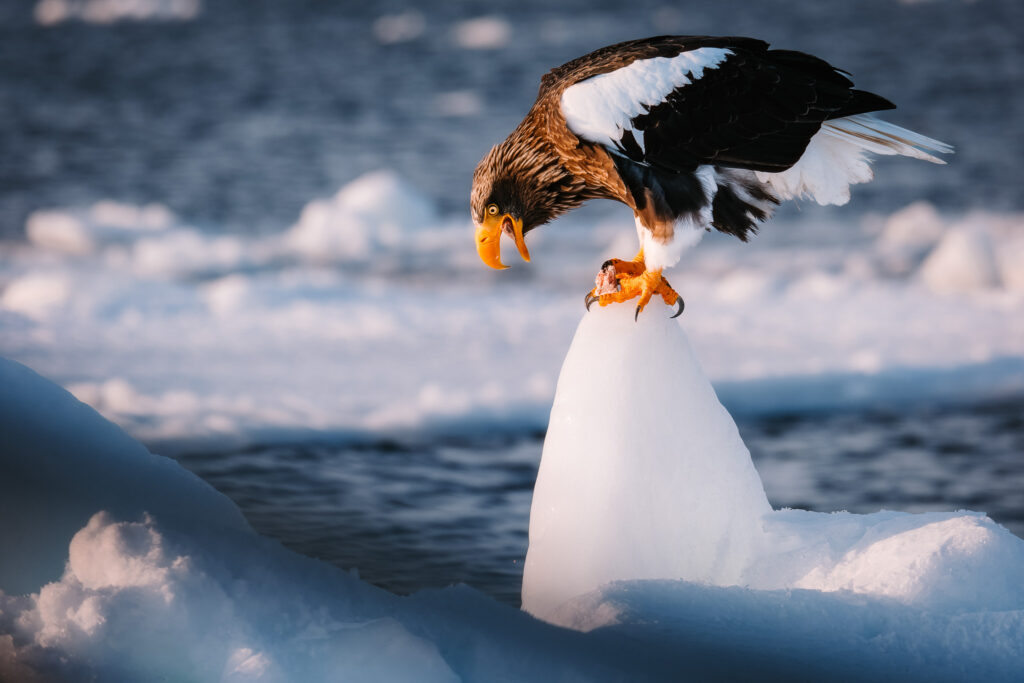
Getting to Rausu
I’m based in Niseko, so for me, the journey to Rausu involves an 8-hour drive across snowy roads—a long but scenic adventure. If you’re traveling to Hokkaido from elsewhere, the easiest option is to fly into Kushiro Airport. From there, you can rent a car and drive to Rausu or take a bus if you prefer not to drive.
Driving in Hokkaido during winter can be challenging, with snow and ice covering most roads. If you’re not experienced with winter driving, I’d recommend exploring alternative transportation options to ensure a safer journey.
Once I finally arrived in Rausu, I checked into an Airbnb I had booked last minute, as I often do. Accommodation in Rausu is limited, especially during peak seasons, and most hotels were already fully booked. The Airbnb was slightly above my budget, but it turned out to be a spacious, warm room with a great view of the ocean—and on clear days, I could even see one of Russia’s islands across the water.
Booking a Boat Tour in Rausu to Photograph Steller’s Sea Eagles
Booking a winter cruise in Rausu can be tricky due to the harsh weather conditions. It’s not uncommon for cruises to be canceled last minute because of bad weather, so I decided to book two mornings in a row, hoping at least one would have good conditions.
Since I left booking late (as I often do), all the sunrise cruises on the first day were fully booked. Sunrise offers the best light for photography, so this was a little disappointing. However, I managed to secure a spot on an 8:30 AM cruise with Shiretoko Nature Cruise (https://www.e-shiretoko.com). For the next day, I found a sunrise cruise starting at 5:30 AM with Shiretoko Aruran (https://shiretoko.life/en). My plan was to keep both bookings and cancel the second one if I got great conditions on the first day.
As it turned out, the first cruise went ahead with decent conditions but less-than-ideal light. Despite that, it was a lot of fun, and I decided to keep my booking for the sunrise cruise the next day. I’m so glad I did—on the second day, the conditions were perfect, with stunning light at sunrise. The experience was absolutely brilliant, and the photos I captured were worth every moment.
The 8:30 AM cruise with Shiretoko Nature Cruise cost around ¥11,000, while the sunrise cruise with Shiretoko Aruran was slightly cheaper at ¥9,900. While the second boat was a bit smaller, both cruises were fantastic. The boats allowed plenty of space to move around and find different angles for photography, which is a big plus.
Next time, if I’m more organized and book in advance, I’ll go straight for the sunrise cruise with Shiretoko Aruran. Not only was it cheaper, but the early light made all the difference for capturing the eagles and the stunning icy landscapes.
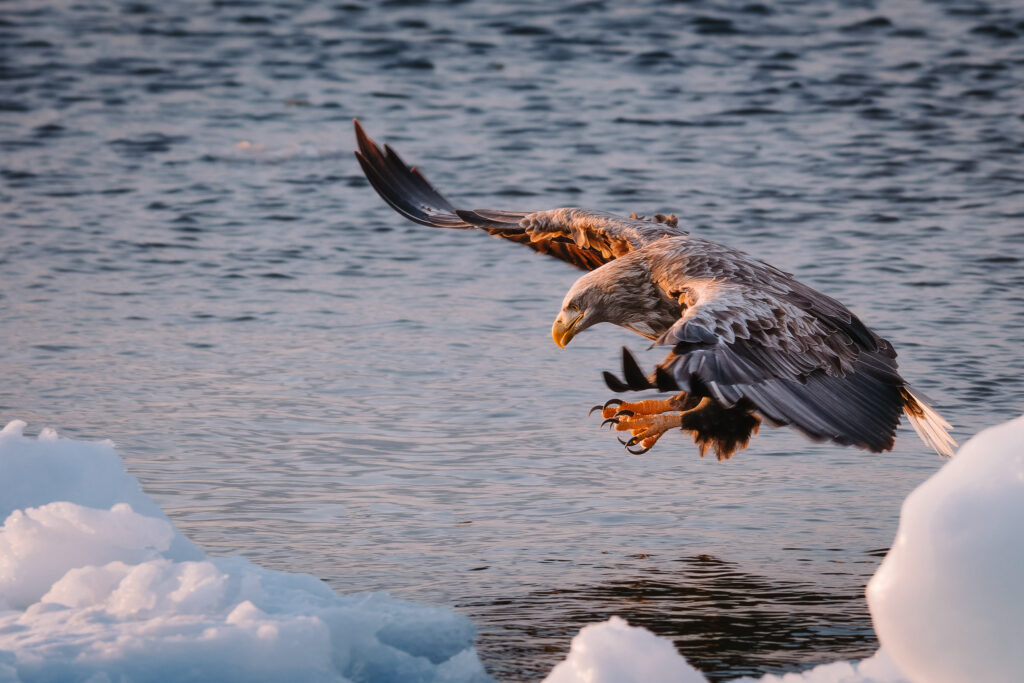
Preparing for the Shoot
Being out on a boat in Rausu during winter is an incredible experience, but it can get brutally cold. Temperatures often drop to around -20°C, and with wind chill on the open sea, it can feel even colder. While you can warm up inside the cabin, staying outside on the deck is essential for getting the best photos. Proper preparation is key to enduring the freezing conditions and making the most of your time.
Dressing for the Cold
To stay warm, I wore multiple layers:
Head and Face: A beanie under the hood of my thick down jacket, and a merino neck warmer (usually reserved for skiing) to cover my face.
Upper Body: A merino base layer, an insulated Icebreaker merino jacket, and my Patagonia down jacket on top.
Legs: A merino base layer, thin down pants, and fleece-lined winter hiking pants.
Feet: Merino ski socks and Sorel insulated winter boots.
Hands: Merino glove liners under Swany mitten ski gloves, which had zippered finger access for operating the camera. I also stuck a disposable hand warmer on the camera grip to keep both the camera and my shooting hand warm.
Camera Gear for Steller’s Sea Eagle Photography
When photographing in such harsh conditions, weather-sealed gear is highly recommended. At the time, I used a Fujifilm X-H2S paired with a Tamron 150-500mm lens for close-up shots of the eagles and a Tamron 17-70mm lens for wider shots and landscapes.
I avoided changing lenses frequently due to the freezing conditions, which meant I missed some opportunities to capture wider shots of the eagles in their environment and landscapes during the stunning sunrise over the Shiretoko Peninsula. I found myself wishing I’d brought a second camera body as I watched a beautiful wide-angle shot slip away. It’s something I’ll prioritize next time and highly recommend to anyone planning a similar trip.
Tips for Success on the Boat
- Dress in Layers: Merino wool is your best friend for its warmth and breathability.
- Protect Your Hands: Use gloves that allow for dexterity, and consider adding hand warmers to your camera.
- Be Weather-Ready: Ensure your camera and lenses are weather-sealed to handle the cold and potential condensation.
- Plan for Versatility: A telephoto zoom lens (like a 150-500mm) is ideal for wildlife, but don’t forget a wider lens to capture the stunning environment.
- Consider a Second Camera: This saves time and reduces the risk of exposing your gear to the elements during lens changes.
The cold in Rausu is no joke, but with the right preparation, you’ll be able to stay out on the deck longer and capture some incredible shots of the eagles and the dramatic winter landscapes
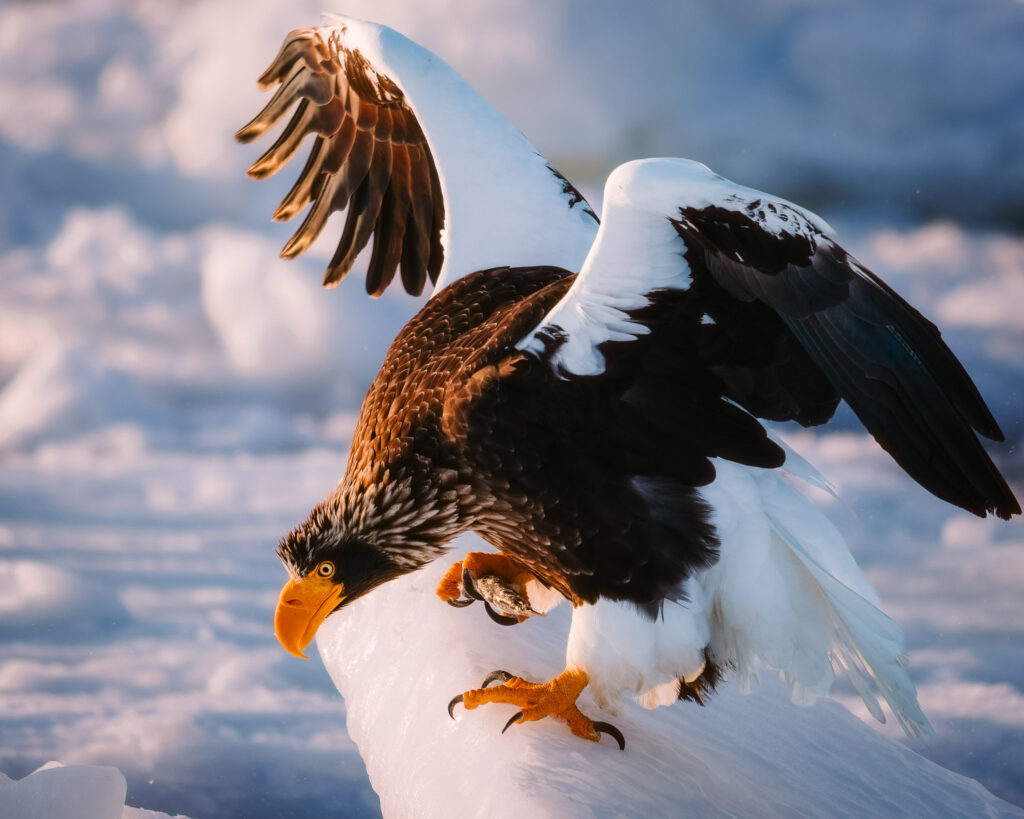
Photographing Steller’s Sea Eagles
First Morning: Overcast Light and Calm Conditions
The first morning started with overcast sky’s and flat light, but thankfully, the conditions were calm with no wind—though well below freezing. From the port in Rausu, we headed out a few kilometers toward the nearby Russian island, as the sea ice wasn’t particularly close to shore that day. At the edge of the ice, we spotted Steller’s sea eagles and white-tailed eagles perched on the higher points, scanning for food, interacting with one another, and taking flight.
To attract the eagles closer for photographers, the boat operators toss frozen fish onto the ice. While this provides a unique opportunity to observe and photograph these incredible birds, it also raises concerns about overfeeding. With multiple boats going out each day, the amount of supplemental food being provided may exceed what is necessary, potentially altering the eagles’ natural behaviors.
While the eagles still hunt naturally and migrate each season, the long-term effects of such frequent feeding are unclear. It’s a reminder of the delicate balance needed in wildlife tourism to ensure that we don’t inadvertently harm the animals we aim to celebrate. For visitors, it’s important to approach these experiences with respect and awareness, supporting practices that prioritize the well-being of the wildlife and their environment.
Onboard, we were free to move around the decks or climb onto the roof of the cabin. I preferred staying on the lower deck, as it offered a better perspective to photograph the perched eagles at eye level. It was also ideal for capturing action shots—eagles taking off, landing, or snatching fish from the water. While the roof provided a good vantage point, the lower deck consistently gave me the best angles.
Despite the flat light, the sight was incredible: broken sea ice stretching out around us, with more than 30 eagles within range of the boat. I captured a mix of photos, from birds perched and interacting to dramatic in-flight shots. Although I was pleased with some of the results, I couldn’t help but wonder how much better the light would be at sunrise. That thought convinced me to keep my second booking for the next day.

Second Morning: Sunrise Perfection
The next morning started early—around 5 a.m.—and it was bitterly cold. We boarded the boat in the dark and huddled in the cabin to stay warm. As we left port, the first rays of sunlight began to illuminate the Shiretoko Peninsula. The golden glow on the rugged, snowy landscape was absolutely breathtaking, and the sunrise light transformed the scene.
When we reached the sea ice, the conditions were perfect. With the soft morning light enhancing every detail, I photographed the eagles again—this time with even more striking results. Steller’s sea eagles and white-tailed eagles soared through the glowing sky, their dramatic wingspans catching the golden light as they hunted and interacted.
Challenges and Lessons Learned from the Boat
As the sunrise unfolded, I switched to a wider lens to capture the stunning landscape and panoramas of the Shiretoko Peninsula. However, I was slow to make the change, as I was too focused on the birds. By the time I adjusted, I had missed the best light for the landscapes. On top of that, I had left my camera bag in the warm cabin. When I brought the lens back out into the cold, it fogged up with condensation, and I had to constantly clear it. Lesson learned: I moved my gear to the deck to acclimatize and avoided the same issue later.
Camera Settings and Techniques
For the flying eagles, I shot at 10 to 15 frames per second to capture the action I could have gone faster than that but i was conserving memory card space. I set my shutter speed to at least 1/1250 or faster to freeze motion, usually shooting wide open at f/5 to f/6.7 depending on the zoom range.
For perched shots, I sometimes stopped down to f/8—not just for better depth of field, but also to move into a sharper range of the lens. This helped ensure maximum clarity in my images, especially when capturing the fine details of the eagles’ feathers.
I used auto ISO, limiting it between the base ISO and ISO 6400. Early in the morning, my ISO reached around 2000, but as the light improved, most photos were shot below ISO 1000. Any images with noticeable noise were easily cleaned up in DXO PureRAW.
To capture dramatic action, like eagles grabbing fish mid-flight, I used Fujifilm’s pre-capture function to nail the timing. For autofocus, while Fuji’s bird detection was helpful, I found it more reliable to use a central zone of focus points with AF-C. This approach gave me a higher success rate.
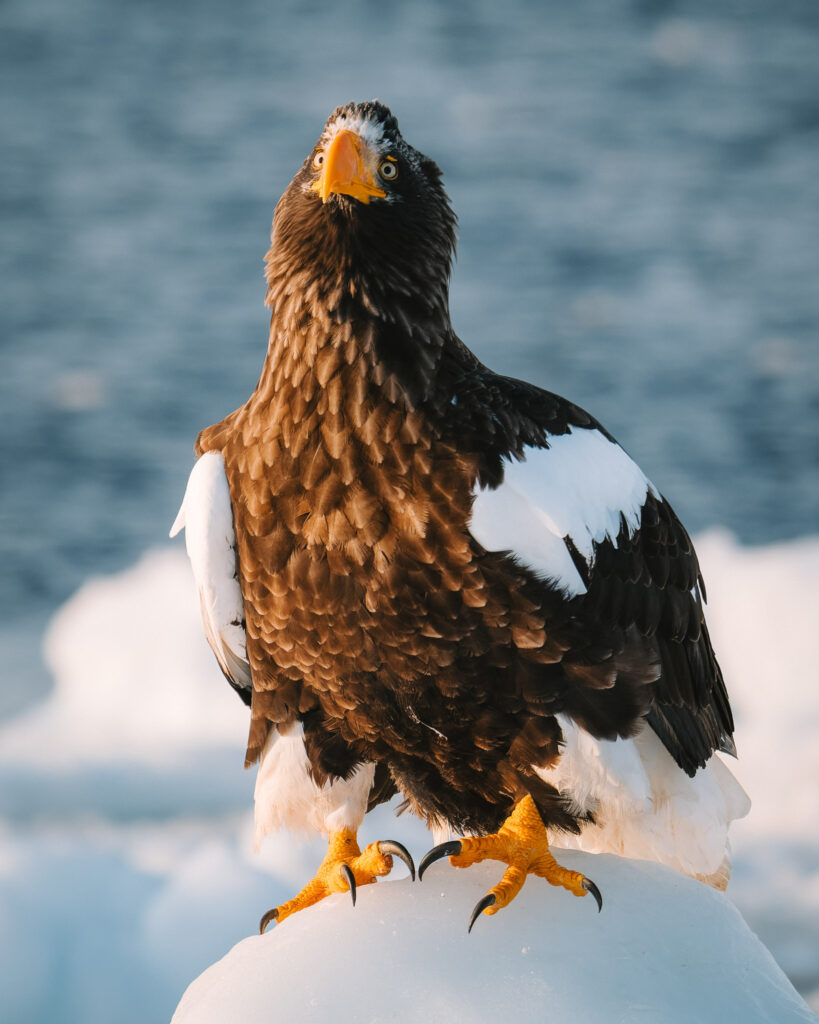
More Opportunities in the Rausu Area
In addition to photographing the eagles, I also explored other incredible locations around Rausu, including the Notsuke Peninsula. This area offers breathtaking winter landscapes with its vast, flat, and frozen expanse. It’s also home to unique wildlife, like herds of Sika deer, which roam the peninsula and create a stark but beautiful contrast against the icy terrain.
The Notsuke Peninsula is a fantastic destination for wildlife and landscape photographers alike. Its quiet beauty and unique atmosphere make it well worth a visit — especially when combined with a trip to Rausu. I’ll share more about these adventures and other nearby gems in future articles—stay tuned!
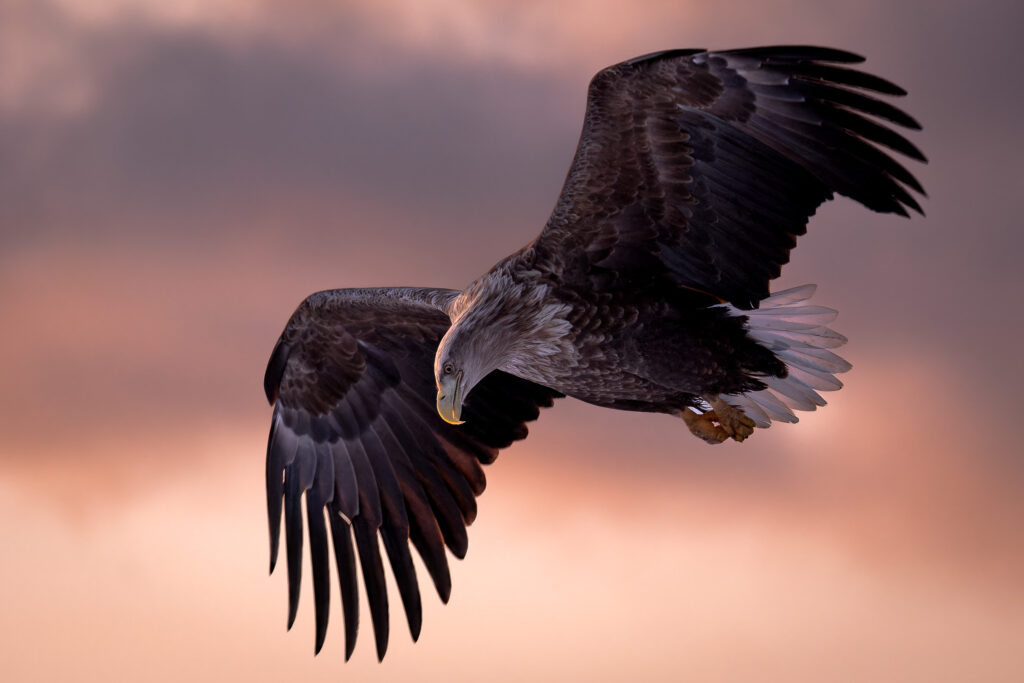
Conclusion
Photographing Steller’s sea eagles in Rausu was an experience I’ll never forget. The combination of incredible wildlife, breathtaking landscapes, and the frozen beauty of the Shiretoko Peninsula made it truly magical.
If you’re passionate about wildlife photography, I highly recommend a trip to Rausu. The early mornings, freezing temperatures, and long drives are worth it when you’re surrounded by such awe-inspiring nature.
Eastern Hokkaido has so much to offer beyond this experience, and I’m excited to share more about the region’s wildlife and landscapes in future articles.
You can browse more stories and photo guides here — and if you’d like to stay in the loop, sign up for my mailing list to get new posts and behind-the-scenes updates straight to your inbox.
Happy shooting!

